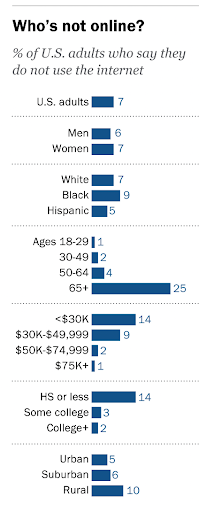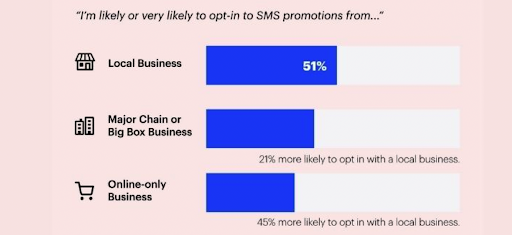
Successful SMS marketing campaigns are not just for national target audiences. Meeting your local customers with relevant, timely messaging can be a welcome addition to their overall customer experience (CX), as well.
Often, when customers complain about brand text messages, it is because those communications are:
- Too frequent.
- Too generic when consumers are craving human-to-human interaction.
- Contain deals or offers that are unclear or irrelevant to them.
SMS messages like these tend to go unopened or result in unsubscribes – not your ideal outcomes. It’s time to inject some best practices designed to put CX at the heart of your SMS campaigns.
In this post, we’ll cover the most relevant local SMS marketing trends that make it a suitable investment for local businesses. You’ll see how SMS marketing campaigns impact local customer experiences and learn actionable ways to improve your enterprise brand’s campaigns at scale.
Why SMS marketing is on the rise
In a recent SMS marketing channel survey, results showed that:
- 55.9% of customers are ready to or already have signed up to receive text messages from multiple businesses
- 24.6% of customers would opt-in for marketing texts only from the right brand;
- The rest of the customers were divided between being unsure or disinterested in receiving text messages from businesses.
Another study showed that 48% of customers preferred direct brand communication via text messages. Compare this to about 25% of customers who find email communication to be better.
These statistics indicate one crucial trend: Customers are not tired of marketing messages and texts. They are tired of poor marketing texts that they will unsubscribe to within seconds.
Depending on your industry, you may also have to be mindful of the internet accessibility that your customer may lack. For example, Pew Research Center has identified that 7% of Americans don’t use the Internet. They break down this number based on many parameters.
Source
Suppose you cater to those sections of society that may have a basic cellphone with limited features. This could be due to a number of factors, including age, income level, or educational qualifications. In that case, SMS marketing might be the only way to reach out to them.
How SMS benefits local customer experience
SMS has a few benefits for the local customer experience that other forms of communication may not be able to provide. While emails have similar benefits, the distinction is that business text messaging has a broader and more reliable reach, amplifying these benefits of SMS marketing.
Source
Reach people throughout all hours of the day
Given the takeover of the Internet in our lives, more and more people are pausing notifications on email apps and other messaging platforms after a specific time of the day. This often is not enabled in SMS tools. Texts are the ideal way to communicate last-minute sales or events limited to those you message (without them seeing the alert until it’s too late).
Amazon introduced a Treasure Truck initiative through an SMS program a few years ago, for example. It allowed customers to know when the Amazon truck full of special deal items (available on the website for higher prices) is passing through a customer’s area. They would inform the customer that they have entered their locality via a text message. The customer could then go pick up the items they want. Amazon thus combined an offline experience with an exciting text message campaign.
Enables clear, concise messaging
SMS forces you to be creative in the most concise way. Brevity enhances the chances of your message being read. Whether it’s simple cart abandonment messages, appointment reminders, or a discount offer, texts that are contextually relevant and short are not likely to be deleted. (Don’t go by the 98% open rate statistic peppered all over the Internet. We open all messages to make the pesky notification alert disappear, don’t we?)
Cost effective marketing alternative
It provides an alternative to in-app notifications. You may not be in the position to launch your app yet. Your customer demographic may not seem inclined to download an app for one brand. In such situations, texts can be an ideal and reliable alternative. A great example is SMS push notifications, which can replace in-app instructions related to deliveries or local curbside pickups. With SMS push notifications, you can ask the customers for any specific instructions they may have pertaining to their order.
You can provide a better local customer experience without setting up complicated email lists or apps with all these benefits.
SMS strategy best practices for local brands
These are some best practices all local brands must incorporate to make the most out of the benefits of SMS marketing.
Best practice 1: focus on conversation, not conversions
Seventy-four percent of customers surveyed as part of the 2021 Local Business Messaging Trends noted that they are likely to communicate with a local business if they know they are not talking to a bot. This doesn’t mean that business texting has to be onerous. Like customer care centers give scripts to their representatives, your business can use collated SMS response templates. This has the added benefit of ensuring consistency across communication without using a bot.
The templates can help initiate a conversation without worrying about drafting each text separately. When the customer responds, the representative can respond in a personalized way.
Personalization doesn’t have to end with adding the customer’s first name. Add identifying factors, such as the fact that they belong to your VIP Program. Prioritize human connection in your messages to customers over sales.
Incorporate as much back and forth as possible to improve customer relationships. The two-way conversation that allows the customer to tell you about themselves makes it seem like they are texting a friend. This dynamic will stop them from unsubscribing to your messages and improve your response rates.
Best practice 2: send customers time-sensitive discounts
The instantaneous nature of SMS marketing should be used for time-sensitive initiatives. Surprise launches, 24-hour discounts, and other urgent marketing initiatives are best communicated through SMS messages. Even if a customer is opening a message to delete it, your message’s urgency may convert them.
SMS coupons have a high conversion rate: 10 times better, to be specific, as the 2021 Local Business Messaging Trends survey shows.
Best practice 3: experiment with links, emojis, gifs, and test
Just because links, emojis, and gifs worked (or didn’t work) in emails or other communication platforms doesn’t mean that will be the same with SMS campaigns. The same intricacies can lead to varied reactions based on the forum. If you can communicate with a gif, you are making your text shorter (and, therefore, more likely to be read).
Make A/B testing your best friend while treating SMS as separate from email, and see what makes sense for your customer.
Best practice 4: Use integrations and SMS marketing tools to streamline affiliate marketing, influencer marketing, and subscription services
Your best bet for incorporating personalization and conversation within your SMS campaigns is to use integrations that automate some processes. Centralize the process of segmentation, assisting customers with support tickets, receiving and responding to customer feedback/reviews, segmenting potential customers, and sending discounts to the customers who haven’t bought from you in a while to win them back. The opportunities are endless when you use integrations while you incorporate text into your local marketing strategy.
Best practice 5: incorporate SMS within an omnichannel marketing strategy
Do not treat SMS strategy as a silo or a standalone communication platform. Make it consistent with other marketing communication channels. For example, use SMS to inform your customer of an order they may have booked through your Instagram. Social media apps are also subject to getting muted sometimes. A simple text reminding customers about their order will ensure they get the update in time.
Send promotional messages through SMS only once you have established a relationship through other channels.
Best practice 6: follow the law (and the boundaries of your customer)
No one wants a random promotional message waking them up at midnight. If you are banking on customers reading the message when they wake up, do a survey to test if that’s the case. Chances are it’s not – customers, especially those with SMS filters that automatically batch brand messages as promotions, don’t often go through the past promotional messages in the morning.
Other boundaries include using a toll-free message for communication, especially if you want to establish a two-way connection. Always have a disclaimer that allows the customer to unsubscribe, even if the law doesn’t mandate it. Explicit consent for business texting is vital for the consumer experience.
Ensure that you are following all data protection laws. If General Data Protection Regulation (GDPR) applies to your business, understand that the penalties are significant. You cannot claim ignorance if you don’t follow the rules laid down related to marketing communication. The laws do not ban SMS marketing but add a few hoops for you to jump through.
Want to be at the forefront of SMS marketing? Work with a local partner like Rio SEO to strategize and get these best practices in motion at scale, across all of your locations.


